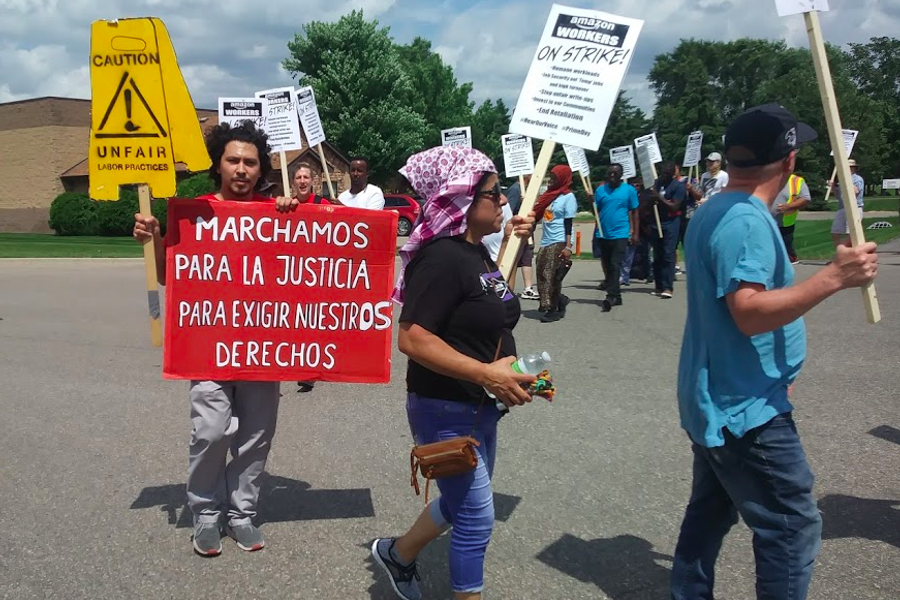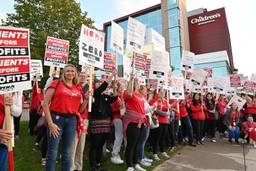
On Monday afternoon, in the blistering heat of a 95-degree day, approximately 50 Amazon workers and community supporters rallied outside of a suburban Minnesota Amazon warehouse chanting, “We work, We sweat, Amazon workers need a rest!” That chant was followed by, “Hey Jeff Bezos! Our backs are tired and our funds are low!”
The crowd was picketing to support workers at the Shakopee, Minnesota warehouse (or “fulfillment center”) who timed their strike to coincide with “Prime Day,” one of the company’s key online sales events. Prime Day is being promoted on Amazon’s website as a “two-day parade of epic deals,” when monthly subscribers to the company’s Prime service can shop for discounted items and expect fast home delivery.
Workers say these deals are taking a toll on those tasked with fulfilling customer orders at a breakneck pace. From 2:00 p.m. to at least 8:00 p.m. on July 15, approximately 100 warehouse employees at the Amazon facility in Minnesota are expected to walk off the job in hopes of calling attention to what they say are unfair working conditions, as well as the company’s reliance on temporary employees.
They are joined by workers at Amazon facilities across Europe who are also be walking off the job, according to Mike Murphy of Quartz, to call attention to labor issues such as stagnant pay and unrealistic work quotas.
The majority of workers at the warehouse are East African immigrants, according to an event announcement for the July 15 strike. There are more than 100 such centers in the United States, but this is the only known facility participating in the walkout. These workers are being assisted by a Minneapolis-based labor rights group called the Awood Center, whose stated mission is to “build economic and political power amongst workers in the East African community of Minnesota.”
Meg Brady has worked at the Shakopee fulfillment center for nearly 18 months, although she says she is currently off the job due to a workplace injury. She joined coworkers and local labor activists on the picket line outside the Amazon facility. As a hot, blustery wind took hold, Brady described the stress fracture in her foot that is keeping her from her work as a “rebinner,” or someone tasked with grabbing items off a conveyor belt and putting them in a cubbyhole.
“I group items for orders,” she said, noting that she has to pull 600 products off the conveyor belt per hour. A big screen mounted in front of her keeps tabs of her work speed. There is pressure to keep up, Brady insisted, as she has seen fellow warehouse workers get written up and sometimes fired for being unable to meet Amazon’s requirements. All of this has led to a repetitive stress injury — one she says she had to fight to get recognized as job-related.
She joined the walkout in solidarity, hoping the workers’ actions will lead to reduced work rates, as well as an investment from Amazon in ergonomics. “Right now, we have poorly designed workstations,” Brady said.
Bryan Menegus of Gizmodo notes that workers at this “infamous” Amazon facility have spent the past year engaging in walk-outs and other actions on behalf of religious freedom and other labor concerns. Thus far, workers have won some concessions, including the right, in 2018, to honor the Muslim holiday of Ramadan during that year’s Prime Day event.
William Stolz also works in the Shakopee fulfillment center and helped organize the strike. In a July 9 interview with National Public Radio, Stolz described his work as a “picker” — someone who works in tandem with robots to put customer orders together, at a rapid pace dictated by Amazon.
Workers want to be treated like “human beings, not machines,” Stolz told NPR, before citing other labor concerns — such as Amazon’s use of temporary workers — as reasons for the planned walk-out. Currently, around 1,500 employees work at the Shakopee facility.
As the strike got underway at 2:00 p.m., a small but growing group of workers and labor activists began to hold picket signs demanding workplace concessions from Amazon, including reduced work rates and allowing more temporary employees to become permanent workers with access to benefits. In response to news of the planned action, Amazon has insisted that it provides competitive wages and benefits in Minnesota.
Still, the July 15 strike comes amid a year of increasing pressure on Amazon to alter its business practices and put labor, climate and human rights first. In 2018, thousands of Amazon workers in Europe mounted their own Prime Day strike, citing such concerns as unfair labor practices and union-busting. Similarly, the company backed off plans for a proposed second headquarters in New York City, thanks in part to union-led pressure.
Amazon began doing business in 1994 and has grown to become a global company with billions in annual earnings. In 2018, the company raked in over $232 billion in revenue and paid zero dollars in federal income taxes, according to sources such as CNBC. First-quarter earnings for 2019 have come in at close to $60 billion, putting Amazon on track to surpass last year’s revenue totals.
One of the company’s central income-boosting strategies has been increasing speed of its product-delivery rate, especially through its fee-based Prime service. The company recently announced plans to pour $800 million into making one-day delivery the standard for Prime members, who pay a monthly fee in exchange for free shipping on millions of products.
Amazon has said that its quick order-turnaround system is accomplished not just by human labor but also by technological advances, including its own Amazon Robotics design.
While Amazon’s earnings continue to grow, however, workers charged with filling orders at faster speeds are working under “endlessly brutal and punishing conditions,” as reporter Ravie Lakshmanan put it. The Guardian has described warehouse workers being injured on the job and then denied benefits or help. In another case, a former Amazon employee said he was fired for supporting unionization efforts.
These conditions led Amazon workers across Europe to go on strike on Prime Day in 2018. This year, Amazon workers at the Shakopee fulfillment center will take up the mantle and engage in a six-hour work stoppage.
So far, this is the only known action planned by Amazon employees in the United States. The striking Minnesota workers were joined, however, by a handful of engineers from Amazon’s Seattle headquarters, who reportedly flew to Minnesota to join the protest and pressure the retail behemoth to take a more active role in addressing climate justice concerns.
Sarah Lahm is a Minneapolis-based writer and former English Instructor. She writes the Midwest Dispatch column for the Progressive magazine, and her work has appeared in other local and national outlets.







